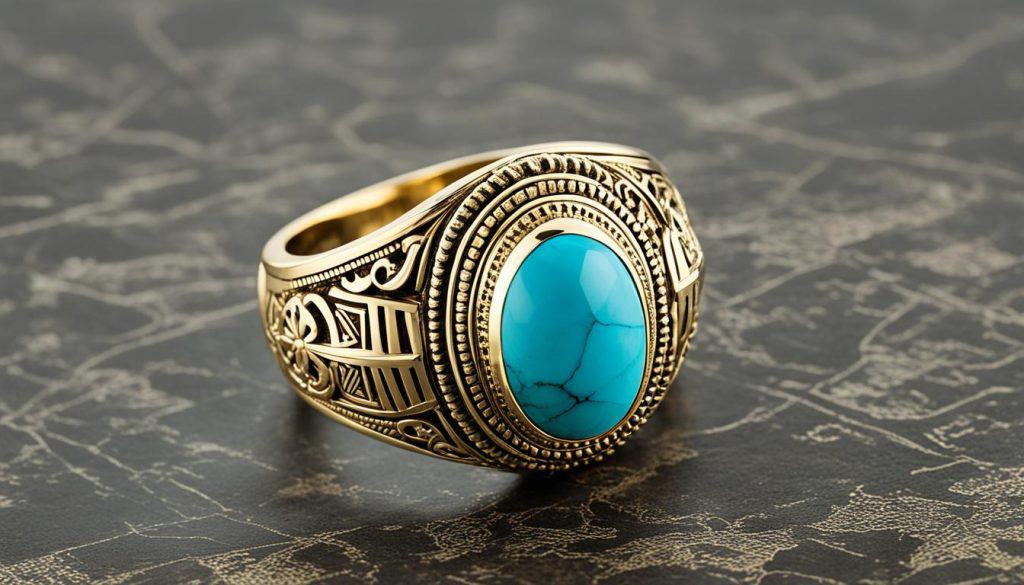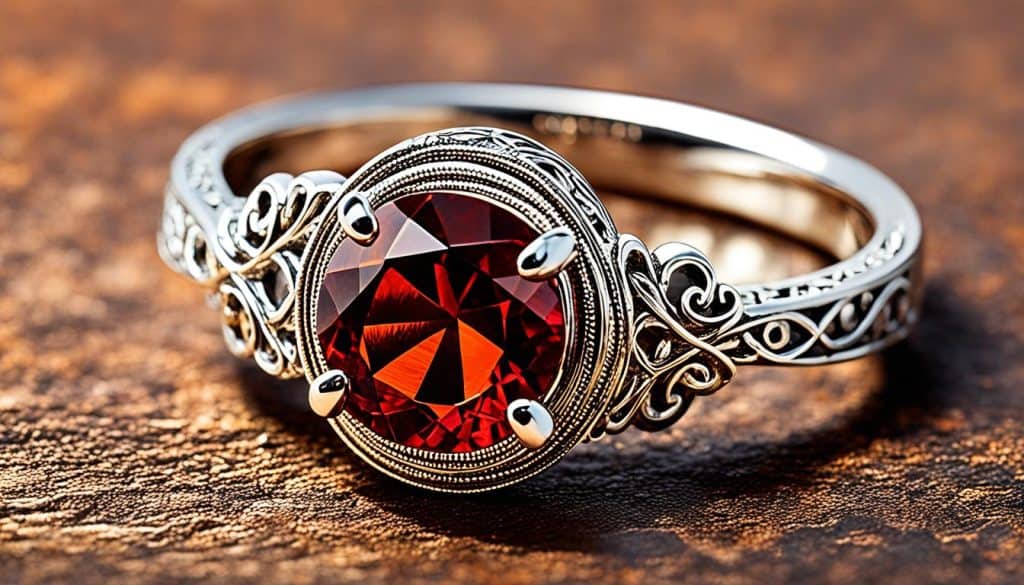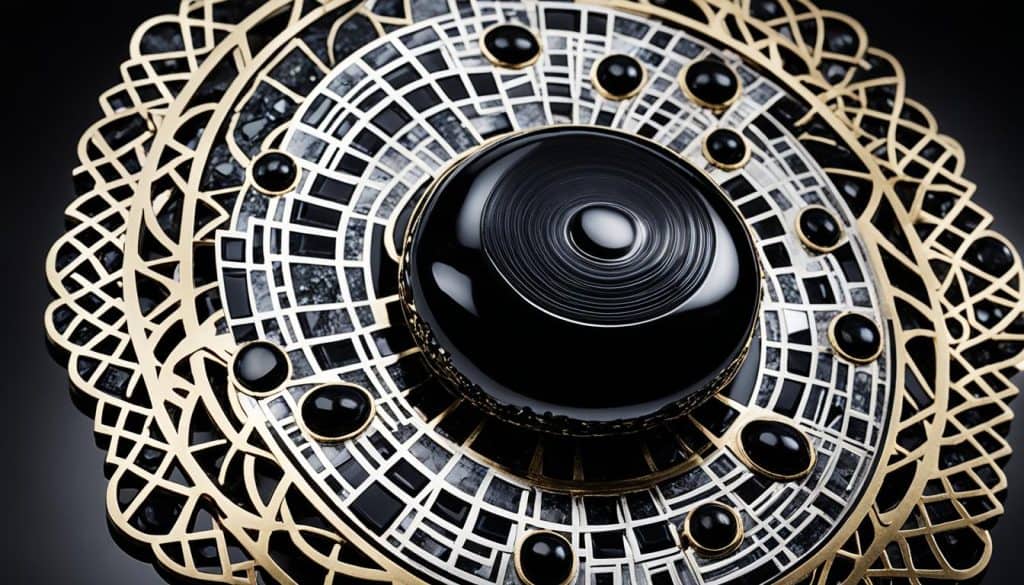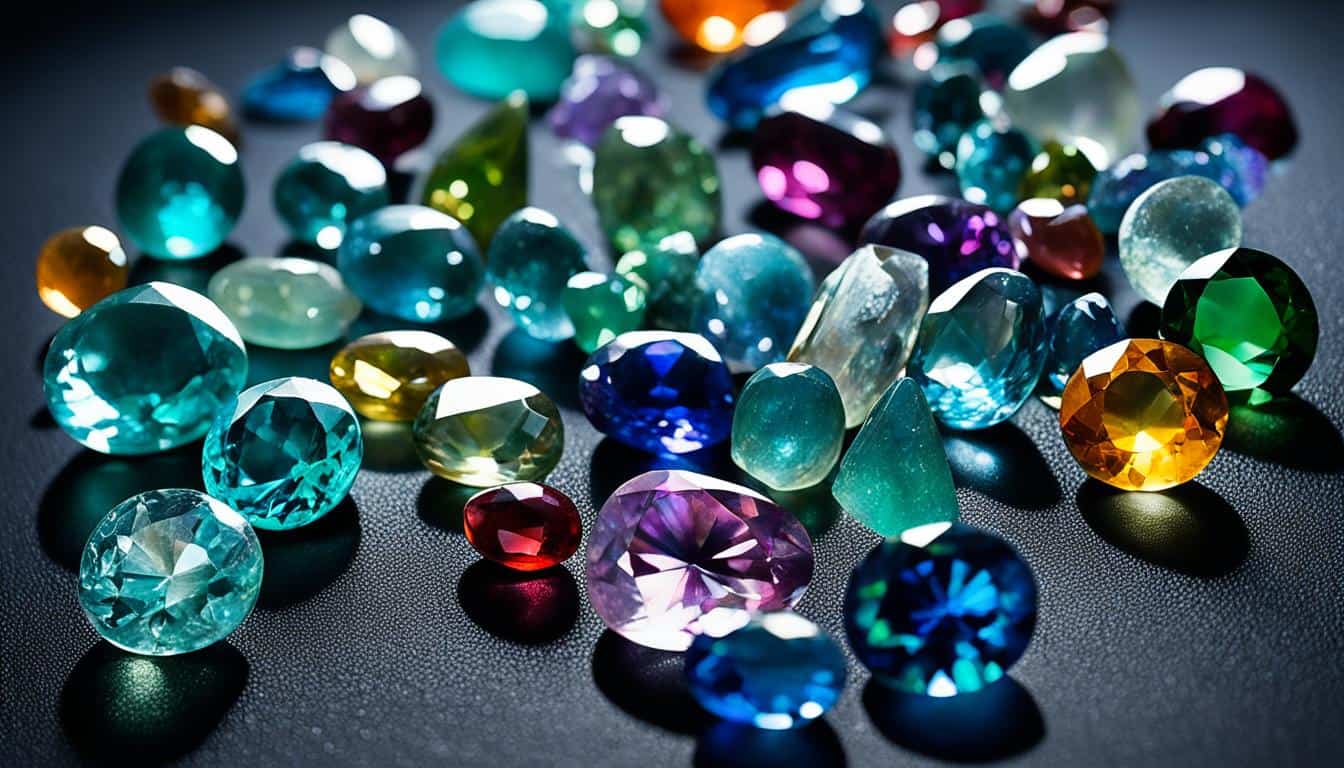Gemstones have always been a big part of our lives, captivating us with their stunning colors and beauty. They’re not just pretty stones; they carry deep meanings and stories. As I explore ancient gems, I find myself drawn into their fascinating tales.
Rubies are linked to love, passion, and energy. Seeing a fiery red ruby can make us feel alive, full of desire and intensity. It’s like rubies unlock our hearts, showing us our deep capacity for love.
Amethyst, with its calming violet color, has its own power. It’s said to help with staying sober and protecting against too much drinking. I believe amethyst can bring clarity, helping those fighting addiction find their way to recovery.
Pearls are another gemstone with a long history of respect. They’re seen as symbols of purity, innocence, and being a woman. Pearls remind us of the ocean’s vastness and the beauty in nature.
Looking into gemstone lore, I see how deeply these stones connect with us. They’re not just pretty things; they’re full of stories and meanings passed down through time.
Key Takeaways:
- Gemstones have deep cultural symbolism and spiritual significance.
- Rubies represent love, passion, and vitality.
- Amethyst is connected to sobriety and protection against intoxication.
- Pearls symbolize purity, innocence, and femininity.
- Gemstones carry stories and meaning that transcend time.
Mesopotamia’s Opulent Obsession: The Mesmerizing Turquoise
Mesopotamia was the birthplace of civilization, known for its love of luxury. The Mesopotamians adored the mesmerizing turquoise. This gemstone was a big part of their culture, symbolizing their beliefs and values.
They wore turquoise to bring protection and luck into their lives. Its colors reminded them of the heavens and the gods. Turquoise was seen as a symbol of life and a connection to the divine.
Turquoise was a big part of their jewelry, amulets, and artifacts. The Ishtar Gate of Babylon was covered in turquoise, showing their love for this gemstone. This gate was a key entrance to the city, showing off their wealth and beauty.
Turquoise meant more than just beauty to the Mesopotamians. It was linked to the heavens and gods, making it a powerful charm against evil and sickness. It was thought to keep its wearer healthy and safe.
The importance of gemstones in Mesopotamia’s history still fascinates us today. Their love for turquoise shows their deep respect for beauty and their strong belief in gemstone power.

The Symbolism of Mesopotamian Turquoise
In Mesopotamian culture, turquoise symbolized:
- Protection and good fortune
- Divine connection and spirituality
- Life and vitality
- Guarding against illness and evil spirits
Turquoise still stirs wonder and interest today, keeping alive the legacy of Mesopotamia’s love for this gemstone.
Cultural Symbolism: Mozambican Garnet and Spirituality
In Mozambique, garnet is very important. It’s seen as a protector, giving strength and vitality. People there believe garnet keeps harm and bad vibes away. They see it as a spiritual guide from the Earth.
The bright red color of Mozambique garnet matches its deep meaning. Red garnets stand for deep love and lasting strength. They’ve always been symbols of bravery and toughness. This makes them a key part of Mozambican culture.
These garnets are known for their clear beauty and special powers. They’re more affordable than rubies but just as beautiful. Each garnet is unique, with its own color and clarity, making it special.
Wearing garnet jewelry brings many benefits. It helps with emotional balance, protection, and connecting with the Earth. It’s said to bring positive vibes, energy, and success. In meditation, it helps focus and connect with your spiritual path.
Mozambique garnet is tough and can be worn every day. It doesn’t scratch easily, so it lasts a long time. When buying garnets, check their color, clarity, and cut to be sure they’re real. Getting a certificate can also prove their quality and origin.
It’s important to think about how Mozambique garnets are mined. We should support fair mining to make sure these gems are used right.
Mozambique garnet is versatile and fits many jewelry styles. Its bright red adds beauty and class to any outfit. It’s a favorite among those who love gems and spirituality.
Overall, Mozambican garnet is a symbol of pride and spirituality. It’s meaningful, affordable, and has healing powers. It’s a top choice for those who value beauty and spirituality.

Eastern Mysticism: Jade’s Balance and Harmony
Jade is a symbol of balance and harmony in Eastern cultures like China and Central America. It has been valued since prehistoric times. In China’s Shang and Zhou dynasties, jade showed the power and virtue of the emperor.
In the 19th and 20th centuries, jade became popular again. This was thanks to the Silk Road, a network of trade routes. It brought jade from China to the Mediterranean and beyond.
Jade is important in Eastern cultures for its healing powers. It helps balance the body, mind, and spirit. It’s linked to the heart chakra, helping to clear negative emotions and improve emotional health.
Jade is also known for healing the nervous system. It has calcium-magnesium, which helps repair and refresh the nerves. It helps heal the kidneys, bladder, and spleen, fighting infections and aiding healing.
Jade has deep spiritual meaning too. It helps clear negative thoughts and boosts self-confidence. This leads to self-love, acceptance, and a closer bond with one’s inner self.
In Eastern cultures, jade is seen as a charm for bringing luck and peace. It’s thought to have magical powers. It’s used in healing, dreamwork, and connecting with the spiritual realm.
Jade’s history, symbolism, and healing powers make it a sought-after gem. It helps people find balance, harmony, and inner peace.
Symbolism and Protection: Black Onyx’s Spiritual Significance
Black Onyx is more than a beautiful gemstone; it’s deeply spiritual and protective. It’s known for its symbolism across cultures, making it popular for jewelry and spiritual use.
Black Onyx is a symbol of protection. It absorbs negative energy and acts as a shield against harm. People wear it to feel calm and to help with mourning and grieving.
It’s also linked to the root chakra, which means stability and grounding. Black Onyx helps connect people with their inner strength. This brings feelings of stability, security, and protection.
Black Onyx also helps the mind, body, and spirit. It balances emotions, improves focus, and clears the mind. In meditation, it boosts intuition and offers spiritual guidance. It brings peace and strength.
Its popularity goes beyond spiritual use. Its deep black color and smooth surface make it perfect for jewelry. People wear it as a symbol of strength and protection.
Throughout history, Black Onyx has been valued for its spiritual qualities. Ancient cultures like the Egyptians, Greeks, and Romans saw its importance. Roman soldiers even wore it in their breastplates for protection.
To get the most from Black Onyx, mixing it with other stones is common. Stones like Lapis Lazuli, Hypersthene, Tiger’s Eye, Aventurine, and Hematite can boost its effects.
Looking for protection, grounding, or spiritual guidance? Black Onyx is a powerful choice. Add it to your jewelry or spiritual practice to feel its benefits.

Gemstone Symbolism in a Globalized World
Gemstone symbolism has spread across the globe, touching many cultures. People from all over value the deep meanings of gemstones. These stones tell ancient stories and carry important cultural values. They offer protection, luck, love, healing, and more to those who seek it.
In Mesopotamia, turquoise was a symbol of life and protection. It was used in jewelry and artifacts. The Ishtar Gate of Babylon is a famous example. In Mozambique, garnet is seen as a symbol of protection and strength, passed down through generations.
Jade is important in Eastern cultures for its balance and purity. It stands for moral integrity and spiritual importance in China and Mesoamerica. Black onyx is also highly valued for its spiritual qualities. It offers protection and grounds people. Warriors have used it as a symbol of strength and courage.
Gemstones like rubies, sapphires, emeralds, and pearls have special meanings worldwide. Rubies in India symbolize passion and protection. In the West, pearls are linked to wealth and purity, tied to royalty and the moon.
Lapis lazuli was a symbol of royalty in Ancient Egypt, connecting humans with the divine. It was used in burial ornaments and amulets for protection. Diamonds are loved globally as symbols of love and eternity.
Opals are cherished for hope, creativity, and luck. Jade is valued for its purity and wisdom. Turquoise is important in Native American cultures for protection and healing.
Gemstones are important in many faiths and beliefs. In Chinese culture, jade symbolizes purity and good fortune. Hinduism links gemstones to the nine planets, using them in rituals for balance. Buddhism uses gemstones in mandalas and prayer wheels for spiritual growth.
Gemstones have always been symbols of power and wealth. They were often worn by the elite. Today, gemstone engagement rings are still popular, symbolizing status and love.
Gemstones have made their mark in art and religion. In the Byzantine Empire, they adorned mosaics, adding beauty to biblical scenes. They continue to inspire and connect us to ancient stories and human history.
Today, the globalized world has made us appreciate gemstone symbolism more. These stones have diverse meanings across cultures. They offer a connection to the past and inspire us with their beauty and significance.
Gems that Transcend Time and Culture
Gemstones have always caught the eye of humans, creating deep cultural ties that last. These stones, filled with stories, are loved in many cultures. They keep inspiring us with their beauty and meaning.
In ancient Egypt, Cleopatra wore lapis lazuli to show her power and wealth. Napoleon Bonaparte wore a sapphire crown to show his authority and greatness. Gemstones have been part of human culture for a long time.
They mean different things to different people and societies. The Koh-i-Noor diamond is thought to bring luck and protection. The Hope Diamond and the Black Orlov Diamond have stories of curses linked to them. Amethyst and sapphire are seen as spiritual stones.
Gemstones have a way of going beyond time and culture. They make us wonder and keep their timeless charm. This is why they still fascinate us today.
